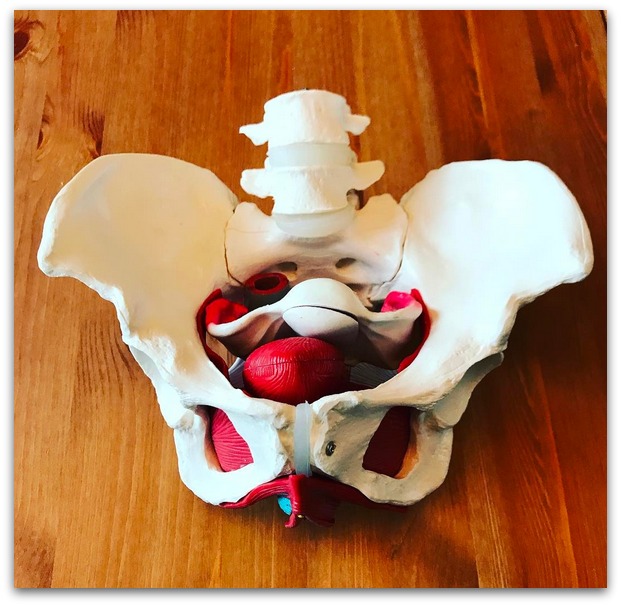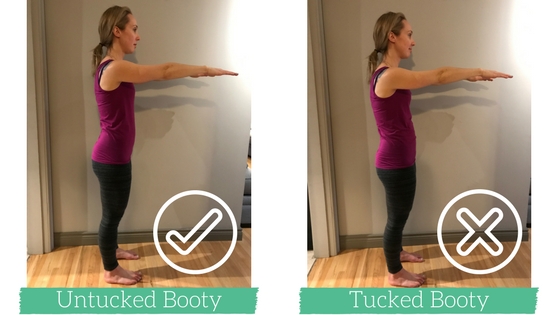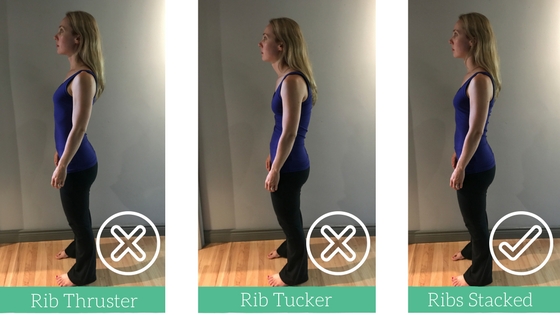
“I pee a little whenever I run.”
“The other day I laughed so hard a little pee came out.”
“I pee during every workout. This is my life now.”
“My youngest daughter is 2 now and I still pee – especially when I do any kind of jumping workout. Hopefully it’s only temporary and will eventually go away.”
These words.
These are the words I see online constantly in mom groups and forums and hear in workshops I’m hosting and during consultations with potential clients.
These words make me simultaneously so sad and so motivated to keep getting the right information into the right hands because peeing yourself is not your non-refundable entry ticket into motherhood.
Having a baby does not mean you need to wear dark or patterned workout pants or pee-proof underwear for the rest of your life because you’re in constant fear of peeing yourself in front of everyone in your workout class.
This isn’t something you have to just live with.
The truth is, if peeing yourself (even just a smidge) was simply part of the package that comes along with a baby, then 100% of women would experience leakage after giving birth.
But this obviously isn’t the case.
So why do some women have problems with leaking and other mamas don’t?
Does it have to do with how big your newborn baby was?
The kind of labour you had?
Whether you gave birth vaginally or with a C-section?
Genetics?
The truth is that there could be so many different reasons why you’re getting some (or a lot of) leakage.
The good news is, regardless what’s causing it, there is help.
And one thing is for sure – just doing kegels isn’t enough.
Why?
Well because your leaks may (strangely) not just be because you have weak pelvic floor muscles – the muscles you’re trying to strengthen with kegels.
 There’s also a right way to do kegels. And many women don’t realize they’re not getting the results they want (like dry underwear) because they aren’t engaging their pelvic floor muscles properly.
There’s also a right way to do kegels. And many women don’t realize they’re not getting the results they want (like dry underwear) because they aren’t engaging their pelvic floor muscles properly.
And there are other muscles that we need to strengthen to help the pelvic floor do its job properly (so we don’t tinkle when we jump).
So what’s really going on? What’s the best way to do a kegel? And what other exercises should you be doing to help stop the leaks?
That’s what we’re chatting about. So grab a tea (or wine – I might just join you for that wine) and dive in, my friend.
Leaks aren’t just caused by weak pelvic floor muscles.
You can actually get leakage not simply because you have too weak pelvic floor muscles, but also because you have too tight pelvic floor muscles (if you want to get all fancy it’s called a hypertonic pelvic floor).
I know this sounds crazy. You’re probably thinking why would I get leaks because my muscles are too tight? Shouldn’t they do a better job of holding in the pee if they’re tight?
Well, if your pelvic floor muscles are too tight, they’re constantly in a flexed or kind-of-engaged position. They’re on and always working so they’re really, really tired and have a tough time reacting fast enough when you need them to act fast (like when you sneeze).
Think about it, if I told you to stay in a half squat for an hour then asked you to suddenly explode up into a jump squat, your poor legs would be so tired from staying in that squat for so long that you may not even get a millimeter off the floor before you collapsed to the ground.
This is what’s going on with your pelvic floor.
Those poor muscles are so exhausted – like newborn mama with triplets exhausted – from being engaged all the time so they’re having a tough time reacting when they need to in order to stop the leakage.
If this happens to be you, relaxing and lengthening your pelvic floor muscles is key.
And kegels do the opposite of that – they can make the muscles tighter and tighter. So they are actually not your bestie if you’re dealing with a tight pelvic floor.
How can you know if this is you?
The best way to tell if you have a hypertonic pelvic floor is to book an appointment with a pelvic health physical therapist or physiotherapist.
They’ll be able to do an assessment and help you relax the muscles and get some relief.
You can also start doing some regular stretching and mobility ball or foam rolling work to help release your pelvic floor muscles.
3 of my fave pelvis releasing stretches are the Inner Thigh Release (I like to use towels underneath my knees to fully relax my legs), Figure 4 and Happy Baby.
These stretches help lengthen and relax the pelvic floor (and the other muscles and tissues attached to it) so it gets a chance to chill and not be so tense all the time.
Here’s a video I posted on Instagram showing you how to do each stretch (you can hold them for as long as you like – or until your toddler comes along and begs you for a snack 😉 ):
Did you know there’s a right way to do a kegel?
Another reason kegel-only vagercise may not be enough to help stop the urge to wee is because you may not be doing kegels as effectively as possible.
Yes. There really is a right way to do a kegel. (Who knew?! Not first-time pregnant Jen. I fell into the camp of “I’ll just squeeze my vagina 100 times a day while I’m pregnant and that’ll work, right?”)
For one thing, when many women do a kegel they put too much focus on the back (the anus) and not enough on the front (where the vaginal opening is).
Go ahead, try it.
Wherever you’re sitting or standing right now do a kegel.
Do you feel it more in the back? The front? Equally throughout your pelvic area?
We want you to be able to feel it both in the front and back as equally as possible.
You can help make that happen by getting in better alignment.
Try these 2 simple cues to help get in better alignment so you can feel it in the back and front:
1. Untuck that booty.
When your butt is tucked, your pelvic floor has a tough time engaging properly. So make sure you have that natural curve in your low back by letting your booty be free.

2. Make sure your ribs are stacked over top of your pelvis.
This can be a tricky one because you may be thinking “Aren’t my ribs always over top of my pelvis?” But the truth is you could be a rib thruster or a rib tucker.
Stand up and take a peek at yourself in the mirror.
If you’re a rib thruster you have a tendency to puff your chest out so your girls are shooting up towards the roof.
If you’re a rib tucker, you have a tendency to hunch over so your girls are pointing down toward the floor.
We want you to aim for the girls pointing ahead, or more parallel with the floor.

Also, a lot of women just squeeze. But what we want you to do is squeeze and lift.
It’s easy to forget the lifting part – especially by the 53rd kegel. So slow it down, take your time, and focus on not just squeezing, but lifting as well.
Some people find it helpful to imagine they’re picking something up with their vagina and anus – like a blueberry. (I know, weird, but potentially helpful).
Now that you have a better grasp on optimal alignment and that it’s a squeeze and lift, let’s try again.
Untuck that booty. Stack those ribs. Relax. Inhale and feel your pelvic floor muscles lower (you should feel them literally move lower in your pelvis).
Next, exhale and act like you’re going to pick something up (like a blueberry) with your vagina and anus – gingerly squeeze and lift your vaginal and anal muscles.
(Gingerly – we don’t want to choke the life outta that blueberry).
And that, my friend is the best way to do a kegel.
How did it feel?
Keep practicing. Keep working on that alignment. (If you’re having trouble with it, I love Julie Wiebe’s example of the ski jump and how that can help you get in optimal alignment).
And be patient with yourself.
You probably won’t suddenly become a kegel rockstar overnight, but being mindful of your alignment and practicing on (gingerly) picking up and lifting your vaginal and anal muscles will help you get the most out of your kegel.
There’s more to your core than the floor.
Finally, kegels aren’t the end-all, go-to because there’s more to the equation than just your pelvic floor muscles.
In order to keep your Lululemons pee-free when you cough, laugh, sneeze, jump and run, a bunch of muscles need to work together – not just your pelvic muscles.
You see your pelvic floor is just one part of your core. Your core is this dynamic system that includes your ab muscles, back muscles, pelvic floor, bum and even your diaphragm.
I say it’s “dynamic” because all these parts are constantly in motion, constantly reacting to our movements. They all work together to stabilize and support our core and entire body.
For example, when you exhale and engage your core your pelvic floor lifts, your transverse abdominis (your deepest ab muscle) pulls in, and your diaphragm contracts.
Everything works together. And if there’s a weak muscle in there somewhere it can affect the entire system.
So leaking isn’t just about being able to squeeze your vagina muscles hard enough to hold it in. Having other strong core muscles that work with your pelvic floor also play a huge role in keeping your pants dry.
So sure, kegels may help. But for most women they won’t be enough because they don’t help strengthen the other muscles in the system.
It’s like with any other part of your body.
If you want to get stronger you can’t just pick one exercise – like bicep curls – and do that every day and assume your entire body is going to get stronger.
The same strategy works when you think about strengthening your core and pelvic floor.
If you want to get stronger and stop leaking you need to do a variety of exercises to strengthen all the muscles of your core and pelvic floor, not just the ones that get lit up when you kegel.
That’s why exercises like these are my fave kinds of movements to recommend to women who need to strengthen their core and pelvic floor to stop the leaking.
They’re simple, whole body movements that are designed to help strengthen the right muscles in the right way so that your entire core and pelvic floor system gets stronger.
Big reminder: you have nothing to be embarrassed about.
Dealing with leaks is the opposite of fun-times.
And now you know there are tools and pros who can support you and help you get your confidence back.
You don’t have to just deal.
If you broke your arm you wouldn’t sit at home, assume it’d fix itself at some point, and avoid going to the doctor because you just can’t bear to see her face when you tell her what happened.
When we’re in pain, or we have an issue anywhere else in our body we get help (usually).
Except if that pain or issue has to do with our sexual organs.
So many women feel too embarrassed to bring this up with anyone – even their doctor.
Sports Medicine Physical Therapist, Julie Wiebe recently did a survey and found that 60% of respondents said they leak during exercise. But only 13% were getting some expert help to deal with it.
If it’s embarrassment that’s stopping you from getting help, you have nothing to be embarrassed about.
1 in 3 women pee themselves at some point after having a baby.
You are not alone.
You do not need to suffer alone.
Just because it has to do with your vagina and urine does not mean you should keep it hush-hush.
Start by making an appointment with a pelvic health physiotherapist or physical therapist so that you can get a hands-on assessment and get the right strategies for your body.
I want you to feel confident wearing whatever color pants you darn well please to your workout class.
Because growing a tiny human doesn’t mean you never get to feel like yourself again.
That sounds rotten and you deserve better.
Hugs,
Jen
Know a mama who’s searching for pee-proof panties? Give her a nudge to check out this post instead.
Leave a Reply